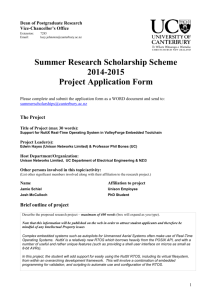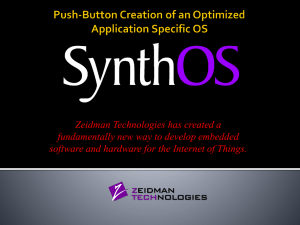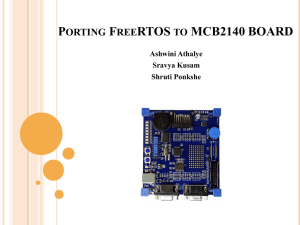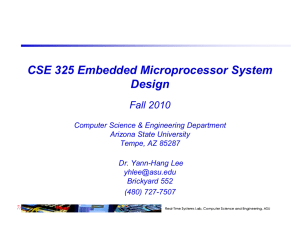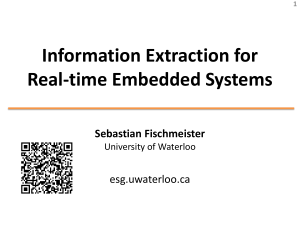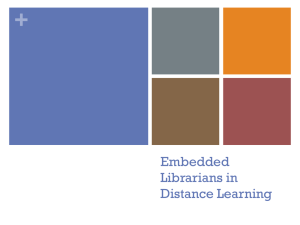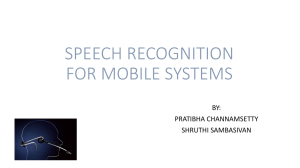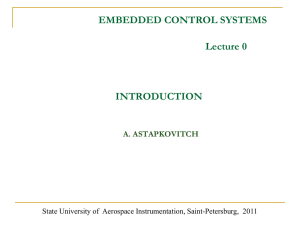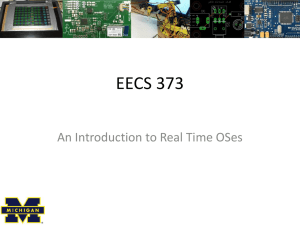RTOS - Computer Science and Engineering
advertisement
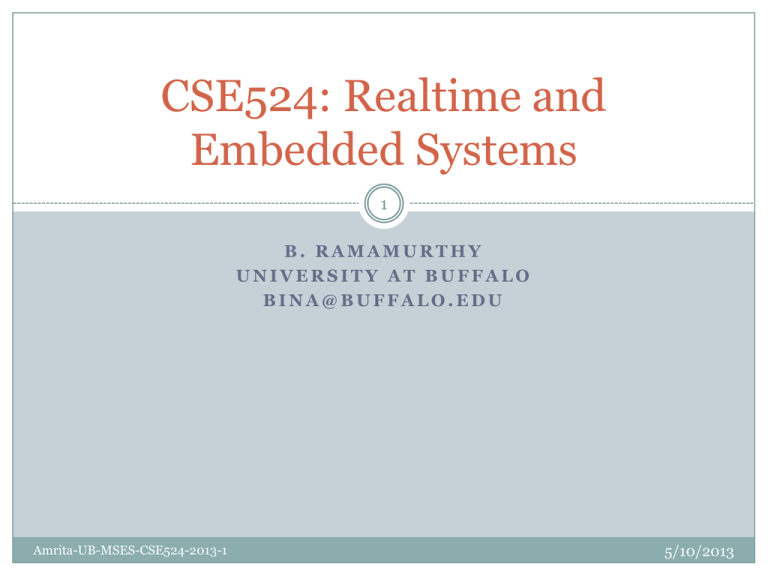
CSE524: Realtime and
Embedded Systems
1
B. RAMAMURTHY
UNIVERSITY AT BUFFALO
BINA@BUFFALO.EDU
Amrita-UB-MSES-CSE524-2013-1
5/10/2013
Amrita-UB-MSES Collaboration
2
Amrita-UB-MSES-CSE524-2013-1
5/10/2013
Outline of Topics
3
Acknowledge organizers
Instructor and students
Overview of the course
Policies and expectations
Syllabus: First-day handout
Format of the course
Learning is a two way street…
Foundations of RTOS
Finally something important, feedback on today’s
class: content, format, pace, missing items,…
Amrita-UB-MSES-CSE524-2013-1
5/10/2013
Motivation
4
What is a realtime system?
What is an embedded system?
What is a realtime embedded system?
Embedded system but not a realtime system
Realtime system but not an embedded system
Why realtime&/embedded system?
How do realtime embedded systems differ from regular
computational systems?
Now lets define and identify some examples of realtime
embedded systems in your work/home environment.
We will attempt a simple design process.
Amrita-UB-MSES-CSE524-2013-1
5/10/2013
Defining RTOS
5
Amrita-UB-MSES-CSE524-2013-1
5/10/2013
Lets define realtime systems
6
Timing: RT systems (RTOS) are required to compute
and deliver correct results within a specified period
of time. Ex: traffic light controller
Interrupt driven: event-driven preemption; RTOS
are often involved with handling events.
Events manifest themselves in terms of interrupt signals
arising from the arrival data at an input port or ticking of a
hardware clock, or an error status alarm.
Amrita-UB-MSES-CSE524-2013-1
5/10/2013
RTOS Definition (contd.)
7
Low-level programming: RTOS often deal with devices; C
language is still a favorite for writing device drivers for new
hardware.
Specialized hardware: Most RTOS work within, or at least
close beside, specialized electronic and mechanical devices.
Often closed loop systems.
Volatile data IO: Variables that change their value from
moment to moment. RTOS software must be structured to
check for changes at the correct rate, so as not to miss a
data update.
Amrita-UB-MSES-CSE524-2013-1
5/10/2013
RTOS Definition (contd.)
8
Multi-tasking: RTOS are often multitasking. Several processes
cooperate to carry out the overall job. Divide RTOS problem into tasks
as a design strategy.
Run-time scheduling: Separation of activities into tasks leads to
question of task sequencing or scheduling. Moreover the external
events and required response to these lead to run-time scheduling or
dynamic scheduling.
Unpredictability in inputs/stimulus: Being event-driven, RTOS are at
the mercy of unpredictable changes in their environment.
Predictability response requirement!
Life-critical code: failure to run correctly may result in death or at least
injury to the user and/or others. Life-critical systems requires extra
testing, documentation and acceptance trials.
Amrita-UB-MSES-CSE524-2013-1
5/10/2013
Types of RTOS
9
Hard RTOS: tight limits on response time, so that a delayed
result is a wrong result.
Ex: jet fuel controller and camera shutter unit
Soft RTOS: need to meet only time-average performance
target. As long as most results are available before deadline
the system will run successfully.
Ex: audio and video transmission, single frame skip is fie, but
repeated loss is unacceptable
Firm RTOS: somewhere between the two.
Ex: Space station solar panel unit
Amrita-UB-MSES-CSE524-2013-1
5/10/2013
Microprocessor
10
Examples: vending machines, mobiles phones, alarm
systems, washing machines, motor car engine
controllers, heart monitors, microwave ovens all
operate using embedded microcontrollers running
dedicated software.
Microprocessors are the enabling hardware for
realtime systems.
Amrita-UB-MSES-CSE524-2013-1
5/10/2013
Embedded Systems
11
Dedicated functionally
Special purpose
Optimized for a certain operations
Small (typically)
Lower power consumption
Embedded within other large systems
Amrita-UB-MSES-CSE524-2013-1
5/10/2013
Embedded Systems
12
• Embedded systems are computing systems with
•
•
•
•
•
tightly coupled hardware and software integration.
Designed to perform dedicated function
Embedded means that the system is a integral part of
a larger system
Multiple embedded systems can co-exist in a single
system.
General purpose processor are typically not aware of
the applications.
An embedded processor is application-aware.
Amrita-UB-MSES-CSE524-2013-1
5/10/2013
Embedded Systems (contd.)
13
• Hardware and software co-design: hardware and
software for the embedded system are developed in
parallel.
• Cross-platform development: Both embedded
system and its application use the cross-platform
development method.
–
Software is developed on one platform but runs on another.
• Software storage will have to be chosen to allow for
upgradeability.
• Of course, the SoC (system on a chip), PoE (Power
on Ethernet), etc.
Amrita-UB-MSES-CSE524-2013-1
5/10/2013
Examples
14
From everyday applications
From automotive domain: Electronic Control Unit (ECU)
Any examples from Bosch?
Amrita-UB-MSES-CSE524-2013-1
5/10/2013
Realtime Embedded Systems
15
RTOS
RTEMB
EMB
Railway monitoring and scheduling : RTOS
Cell phone: EMB
Heart pacemaker: RTSEMB
Amrita-UB-MSES-CSE524-2013-1
5/10/2013
Exercise#1
16
Lets identify 10 embedded systems, realtime systems and
realtime/embedded system
I will begin with Arduino Uno
Example
Amrita-UB-MSES-CSE524-2013-1
Type; justification
5/10/2013
Embedded Systems
17
Amrita-UB-MSES-CSE524-2013-1
5/10/2013
Designing RTOS
18
WHERE DO YOU BEGIN?
ANS: REQUIREMENTS
Amrita-UB-MSES-CSE524-2013-1
5/10/2013
Functional and non-functional requirements
19
Functional: Describes the explicit operations to be performed by the RTOS.
If you consider the climate control system in an automobile:
Sense temperature: T1
Compare with user set temperature: Tset
If T1 > Tset, start cold air fan
Else if T1 < Tset, start hot air fan
Non-functional: describes the quality of the operations
Example: Need to control temperature within 0.5 degree error
Accuracy
Precision
Reliability
Safety
Response time
Responsiveness
Predictability
Deadlines
Amrita-UB-MSES-CSE524-2013-1
5/10/2013
Hardware Requirements
20
Hardware support for functional requirements
Hardware support for non-functional requirements
Size of the device
Power of the processor
Power consumption
Speed of the device
Support for devices, interrupts
Electronic Control Units (ECU): typical modern
automobile has 100’s of ECUs [Takada]
Amrita-UB-MSES-CSE524-2013-1
5/10/2013
Software requirements
21
Software functions to implement the operations
Driver that dispatches calls to these operations
Interrupt handlers
Device drivers
Operating system
Typical modern automobile has millions of lines of
software [Takada]
Amrita-UB-MSES-CSE524-2013-1
5/10/2013
Software Quality Assurance
22
QA is especially important to RTS since many of
these are deployed in life critical environments /
situations.
Patriot missile failure
Amrita-UB-MSES-CSE524-2013-1
5/10/2013
Design Representation
23
Discovering modules: CRC Classes, Responsibilities, and
Collaboration
For teams working together to discover modules of the
system
Once modules are discovered, UML (Unified Modeling
Language) state diagrams offer a convenient method to
represent a RTES.
We will look at CRC later;
Today we will look at a finite state machine (FSM) for
representing the design of a RTOS.
On to activities…
Amrita-UB-MSES-CSE524-2013-1
5/10/2013
Design Considerations
24
Requirements Design representation
Design representation prototype
Prototype testing
Production system
Amrita-UB-MSES-CSE524-2013-1
5/10/2013
Exercise #2
25
Automatic vending machine money counter
Embedded system (Rs.5 counter)
Coins: 1, 2 and 5 rupees
2
S1
S3
1
5
1
5
S2
2
2
S4
5
1
1
2,5
1
2
S0
5
S5+
S5
Amrita-UB-MSES-CSE524-2013-1
5/10/2013
Finite State Machine (FSM)
Pag
e 26
An FSM M = five tuple { S, i, T, Σ, δ }
S = set of states
i = initial state
T = terminal state (s)
Σ = events that bring about transitions
δ = transitions
Lets do this exercise for the avionics for fighter
aircraft
Amrita-UB-MSES-CSE524-2013-1
5/10/2013
Summary
27
We studied the basic definitions of realtime and
embedded system.
We studied key issues which make development of
realtime software more challenging than desktop or
traditional data processing applications.
Timing is very critical for RTOS input, output,
computing and response.
UML state diagram is a useful tool for design
representation.
We will study the design and implementation of
RTOS system in detail later on.
Amrita-UB-MSES-CSE524-2013-1
5/10/2013
